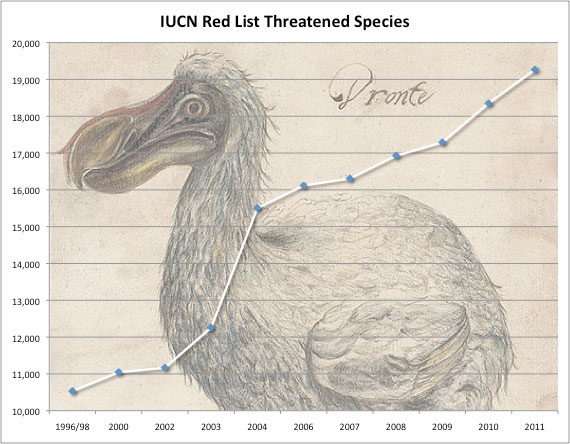
Previously unpublished 17th Century Dutch sketch of the dodo, taken from a real specimen, either alive or stuffed. Dronte means dodo in Dutch.
The past twelve months have seen 914 species added to the threatened list by the world’s authority of species endangerment, the International Union for the Conservation of Nature (IUCN)’s Red List. Over 19,000 species are now classified in one of three threatened categories, i.e. Vulnerable, Endangered, and Critically Endangered, a jump of 8,219 species since 2000. Species are added to the threatened list for a variety of reasons: for many this year was the first time they were evaluated, for others new information was discovered about their plight, and for some their situation in the wild simply deteriorated. While scientists have described nearly 2 million species, the IUCN Red List has evaluated only around 3 percent of these.
“The key to halting the extinction crisis is to target efforts towards eradicating the major threats faced by species and their environment; only then can their future be secured,” explains Simon Stuart, Chair of IUCN’s Species Survival Commission in a press release. “The IUCN Red List acts as a gateway to such efforts, by providing decision makers with a goldmine of information not only on the current status of the species, but also on existing threats and the conservation actions required.”
New Evaluations
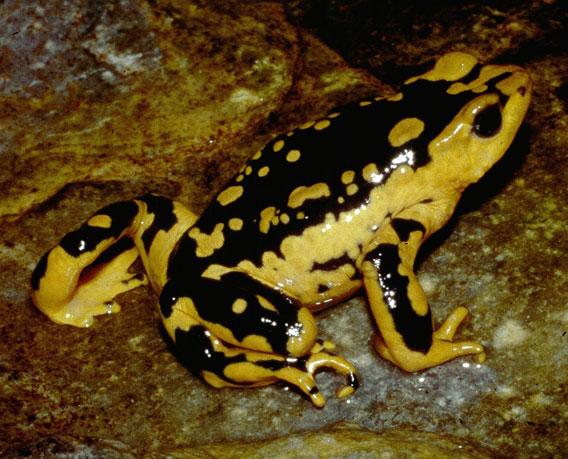
A drastic population decline, estimated to be more than 80% over the last ten years, has been inferred from the apparent disappearance of most of the population of Atelopus patazensis. Only two individuals of this species were located in extensive surveys in 2010. This decline in Atelopus patazensis might be due to chytridiomycosis and/or a combination of mining activities and the chytrid fungus. More research on this Critically Endangered species’ population status, natural history and threats are urgently needed to ensure that proper conservation measures can be put in place. Photo by: Alessandro Catenazzi.
Nineteen species of amphibians were added to the list this year, and a stunning eight of these were listed as Critically Endangered, including a yellow-and-orange harlequin toad (Atelopus patazensis) from Peru and a dwarf salamander (Dendrotriton chujorum) from Guatemala. According to the Red List, amphibians are among the world’s most threatened groups: 41 percent of the world’s frogs and salamanders are currently facing extinction. Habitat loss, invasive species, pollution, and a lethal plague, known as chytridiomycosis, have decimated amphibian populations worldwide. The IUCN Red List has evaluated 93 percent of the world’s nearly 7,000 amphibians. However, a recent study predicted that a further 3,000 amphibians likely still remain unknown to scientists.
This year was the first time that New Caledonia’s endemic reptiles were evaluated. For those species where there was sufficient data to make a determination, 67 percent were threatened with extinction. The forests of New Caledonia—incredibly rich in species found no-where else—were recently listed by Conservation International as the world’s 2nd most threatened forest biodiversity hot spot, since only 5 percent of the islands’ forests remain. Deforestation, widespread nickel mining, and introduced species, have decimated the islands’ unique residents.
The IUCN Red List also assessed all 248 lobster species this year. Unfortunately over a third (35 percent) were listed as Data Deficient, meaning there was simply not enough information on the species to determine its status.
On the Positive Side
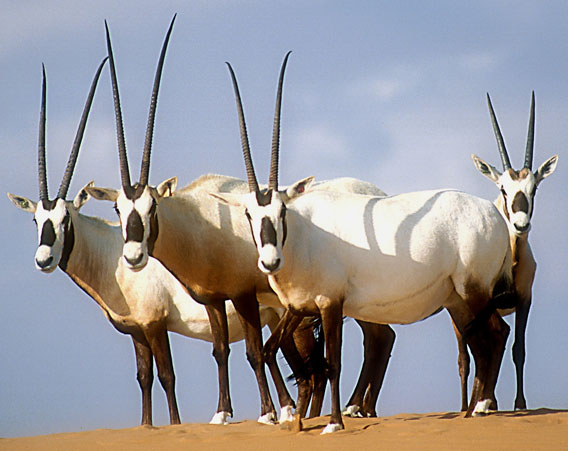
Formerly occurring throughout most of the Arabian Peninsula, the Arabian Oryx has been reintroduced to five countries. Illegal live capture for sale to private collections remains a constant threat, and poaching continues to threaten individuals who wander outside of release sites. Drought and overgrazing have affected habitat quality in places, limiting potential future release sites. Despite these issues, its relatively steady wild population growth qualifies the Arabian Oryx to be downlisted in 2011 from Endangered to Vulnerable. Photo by: David Mallon.
This year’s update was not entirely gloomy. One bright spot was the movement of the Arabian oryx (Oryx leucoryx) from Endangered to Vulnerable. The Arabian oryx’s story is an amazing one of a species coming back from extinction—literally—to run free again.
Hunting killed off the Arabian oryx, with the last wild individual shot dead in 1972. However, a captive conservation program, which started with only 9 animals, managed to save the species from complete oblivion. Once a secure population was created in captivity, animals were released back into the wild. Today, the wild population is 1,000 animals. This is the first time a species has made it all the way from being listed as Extinct in the Wild to Vulnerable.
“Conservation does work and species can recover, as shown in the case of the Arabian Oryx. Using data from the IUCN Red List, an opportunity exists for governments and society to guide conservation programmes to put the brakes on species extinctions,” said Julia Marton-Lefèvre, IUCN’s Director General, in a press release.
Gaps in the Red List
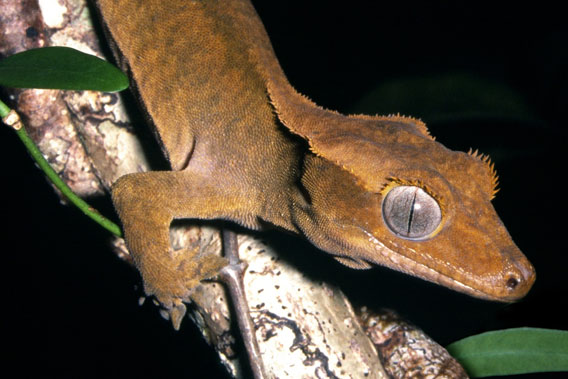
The Crested Gecko (Rhacodactylus ciliatus) has a restricted distribution and only occurs in Grand Terre and Ile des Pins, New Caledonia. This nocturnal gecko has been assessed as Vulnerable. The main threat within its range is habitat loss associated with logging, wildfires and the clearance of forests for agriculture. Predation by rodents and the impact of the introduced ant Wasmannia auropunctata are other potential threats to the Crested Gecko. Monitoring of the current population and measures to control impacts of invasive species are needed. Photo by: Tony Whitaker.
The IUCN Red List’s assessments are heavily weighted toward more well-known species whose statuses are easier to determine. For example, while the Red List has only assessed 3 percent of the world’s described species, it has assessed 100 percent of the world’s birds and mammals, and 93 percent of the world’s amphibians.
Two other groups of vertebrates—reptiles and fish—have not had such a complete assessment. Only 32 percent of the world’s known reptiles have been assessed, and 29 percent of the world’s fish.
However, non-vertebrates are even more lacking in assessment. In all, only 1 percent of the world’s invertebrates have been assessed: from 39 percent of the world’s corals to 0.03 percent of the world’s spiders. Researchers have assessed over 3,000 insects, the most numerous life forms described on Earth, but this is only 0.3 percent of the world’s known insects.
Plants fare slightly better. In total 5 percent of the world’s described plants have been assessed by the IUCN Red List, but very few algae or mosses.
Fungi are the least assessed of all: there are over 30,000 known mushrooms, but only one has been assessed by the Red List.
The reason for the gaps are twofold. On the one hand the lesser-known the species the more difficult it is to assess. On the other hand, is the practical lack of funding. Last year researchers said it would take $60 million dollars to triple the number of species now assessed, thereby creating a true ‘barometer of biodiversity’. Such funding would allow researchers to assess an additional 35,000 vertebrates, 38,000 invertebrates, 25,000 plants, and 14,500 fungi and other species. While $60 million may sound like a lot, it’s just over 1 percent of how much the US continues to spend on subsidies for big oil companies.
“It is extremely important that we keep pushing forward with surveys of little-known species, as without adequate data, we cannot determine their risk of extinction and therefore cannot develop or implement effective conservation actions which could prevent the species from disappearing altogether,” explains Jane Smart, Director, IUCN’s Global Species Program.
Currently, much of the work for the IUCN Red List is done by volunteers, given the dearth of funding.
Current estimations from the IUCN Red List indicate that extinction rates are currently happening 100-1,000 times more than the natural rate as determined by fossils. Many scientists believe we heading into a period of mass extinction—the sixth on Earth—only this time it is due wholly to one species’ activities. From deforestation to climate change, pollution to wildlife consumption, invasive species to habitat destruction, humans are driving massive changes to the world’s biodiversity.
Related articles
Amphibian-plague strikes frogs harder in pristine ecosystems
(05/31/2011) Frog populations worldwide are facing two apocalypses: habitat destruction and a lethal plague, known as chytridiomycosis. Over 30 percent of the world’s amphibians are currently threatened with extinction and it is thought at least 120 species have gone extinct in just the last 30 years. Unfortunately, a new study in Proceedings of the National Academy of Sciences (PNAS) finds that the two threats—habitat loss and chytridiomycosis—are likely to leave no frog population undisturbed. According to the study, frogs that live in still-pristine habitats are more susceptible to chytridiomycosis than those that are already suffering from habitat loss.
3,000 amphibians, 160 land mammals remain undiscovered—that is if they don’t go extinct first
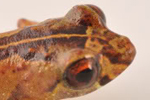
(05/18/2011) Remote little-explored rainforests probably harbor the majority of undiscovered amphibians and land mammals according to a new study in Proceedings of the Royal Society B. The study calculated that it’s likely 33% of the world’s amphibians and 3% of terrestrial mammals still remain unknown. However, the paper also found that these undiscovered species are likely in worse peril of extinction than already-described species.
More biodiversity equals cleaner water, but why?
(04/07/2011) A new landmark study not only proves that adding more species to a freshwater stream linearly increases the ecosystem’s ability to clean pollutants, but also shows why. The study, published in Nature found that by increasing the biodiversity of a lab controlled mini-stream from one algae species to eight caused the ecosystem to soak up nitrate pollution 4.5 times faster on average. To conduct the experiment, researchers used plastic to create 150 mini model streams. Molding the plastic, they recreated real stream-like habitats such as pools, runs, and eddies. Different species of algae gravitated toward particular mini-habitats, creating special ecological niches and allowing more of the stream to be utilized by the algae for soaking up the nitrate pollution. Less utilization of the available habitats resulted in a dirtier river and vice-versa.
Rich plant diversity leads to increased productivity, ecosystem services
(03/08/2011) A new study finds that diversity of plant species matters—big time. Analyzing nearly 600 research studies, the meta-study in the American Journal of Botany found that productivity in biodiverse plant ecosystems was 1.5 times higher than in monocultures. In other words, a prairie is more productive than a cornfield and forest more productive than a rubber plantation. The researchers warn that eroding plant diversity threatens essential ecosystems services such as food, water purification, oxygen production, carbon sequestration, and the availability of raw materials.
World’s sixth mass extinction still preventable
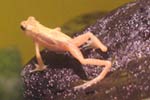
(03/03/2011) So, here’s the good news: a mass extinction, the world’s sixth, is still preventable. But the bad news: if species currently threatened with extinction vanish—even over the next thousand years—homo-sapiens will be the first single species responsible for a mass extinction. Comparing today’s current extinction crisis with the big five that occurred in the past, a new study in Nature finds that while the situation is dire, the choice is ultimately up to humanity. “If you look only at the critically endangered mammals—those where the risk of extinction is at least 50 percent within three of their generations—and assume that their time will run out, and they will be extinct in 1,000 years, that puts us clearly outside any range of normal, and tells us that we are moving into the mass extinction realm,” explains lead author Anthony D. Barnosky, UC Berkeley professor of integrative biology.
Top 25 most endangered turtles: Asian species in crisis
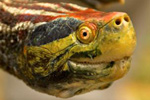
(02/23/2011) Surviving hundreds of millions of years on Earth have not saved turtles from facing extinction at human hands. A new report by the Wildlife Conservation Society (WCS) and the Turtle Conservation Coalition, identifies the world’s 25 most imperiled turtles, including one that is practically assured extinction: ‘Lonesome George’ the last Abdington Island tortoise in the world. The list includes four turtle species from South and Central America, three from Africa, and one from Australia. But Asia is the hotbed for turtles in trouble with 17 of the top 25 species, or 68%. The numbers are even more alarming if one looks only at the top ten: eight of the top ten are in Asia, and six of these in China.
Worldwide search for ‘lost frogs’ ends with 4% success, but some surprises
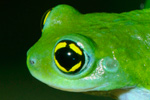
(02/16/2011) Last August, a group of conservation agencies launched the Search for Lost Frogs, which employed 126 researchers to scour 21 countries for 100 amphibian species, some of which have not been seen for decades. After five months, expeditions found 4 amphibians out of the 100 targets, highlighting the likelihood that most of the remaining species are in fact extinct; however the global expedition also uncovered some happy surprises. Amphibians have been devastated over the last few decades; highly sensitive to environmental impacts, species have been hard hit by deforestation, habitat loss, pollution, agricultural chemicals, overexploitation for food, climate change, and a devastating fungal disease, chytridiomycosis. Researchers say that in the past 30 years, its likely 120 amphibians have been lost forever.
From Cambodia to California: the world’s top 10 most threatened forests

(02/02/2011) Growing populations, expanding agriculture, commodities such as palm oil and paper, logging, urban sprawl, mining, and other human impacts have pushed many of the world’s great forests to the brink. Yet scientists, environmentalists, and even some policymakers increasingly warn that forests are worth more standing than felled. They argue that by safeguarding vulnerable biodiversity, sequestering carbon, controlling erosion, and providing fresh water, forests provide services to humanity, not to mention the unquantifiable importance of having wild places in an increasingly human-modified world. Still, the decline of the world’s forests continues: the FAO estimating that around 10 million hectares of tropical forest are lost every year. Of course, some of these forests are more imperiled than others, and a new analysis by Conservation International (CI) has catalogued the world’s 10 most threatened forests.
Study: REDD could save species from extinction, if well-funded
(12/01/2010) The burgeoning global program REDD+ (Reduced Emissions from Deforestation and Forest Degradation) could do more than mitigate climate change, according to a new study in Conservation Letters by scientists with Conservation International (CI). Analyzing a sample of 2,500 forest animals, including mammals, birds and amphibians, researchers found that REDD+ could reduce the rate of extinction among these species by 46-82% over five years. The wide range in the study’s findings depends on the amount of funds devoted to REDD+: more funds means greater forest preservation and, thereby, less extinction.
Ad warning of mass extinction appears in Times Square
(11/24/2010) An advertisement warning holiday pedestrians about mass extinction—and asking for their help—first appeared in Times Square this week. The ad which flashes on CBS’s Super LED Screen between 7th and 8th avenues was created by US conservation organization, the Center for Biological Diversity.
Will biodiversity agreement save life on Earth?

(11/07/2010) On Friday, October 29th, 193 member nations of the Convention on Biological Diversity (CBD) reached a possibly landmark agreement on saving the world’s suffering biodiversity in Nagoya, Japan. The agreement was especially notable after nations failed—by all accounts—to live up to the goals from the previous CBD agreement, including stemming the global loss of biodiversity by 2010. According to scientists, the world’s species continue to vanish at mass-extinction rates due to habitat loss, deforestation, overconsumption, pollution, climate change, and invasive species. To addresses this crisis the new CBD agreement sets out 20 goals for 2020. But given the global challenges in saving the world’s species and the lack-of-teeth in agreement (it is strictly voluntary), will the CBD make a difference or in ten years time will goals be again unmet and life on planet Earth worse off than ever? To answer this mongabay.com turned to a number of experts in the conservation world.